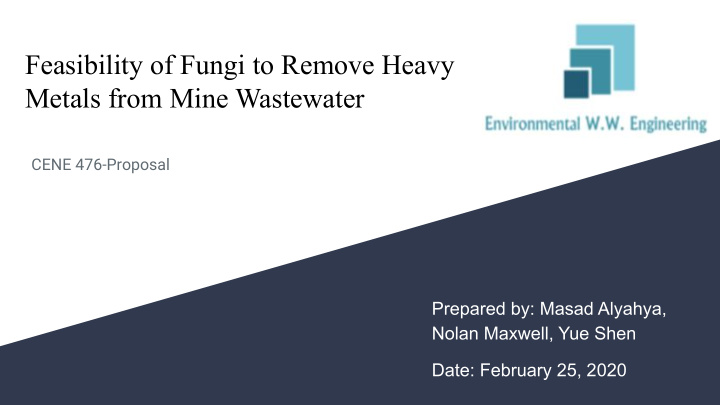



Feasibility of Fungi to Remove Heavy Metals from Mine Wastewater CENE 476-Proposal Prepared by: Masad Alyahya, Nolan Maxwell, Yue Shen Date: February 25, 2020
Introduction Purpose: Test the ability of fungi to remove heavy metals from ● mine wastewater. Client: Dr. Bridget Bero ● ● Location: NAU Environmental (ENE) Lab & Science Lab Facility (SLF) Mycology Lab Background :Previous research showed that Aspergillus sydowii ● is capable of removing Chromium and Fusarium verticillioides is capable of removing Calcium and Magnesium from water [1][2]. 2
Project Scope Task 1: Select Fungi and Metals Contaminants Task 1.1 Literature Review: - Determine 2 types of fungi and metals Task 1.2 Interview A Mycologist - Get some informations and suggestions Task 1.3 Final Selection of Fungi and Metals - Decision Matrix Figure 1: Cultivated Sample of Aspergillus sydowii [3] 3
Project Scope Task 2: Cultivate Fungi Task 2.2.1 Sterilization Task 2.1 Authorize Environmental Engineering Laboratory Use - Autoclave - Create a Protocol Binder Task 2.2.2 Inoculation and Growth Task 2.2 Obtain and Growth Fungi - Laminar Flow Hood Specimens - Storage within Lab - Purchase Spawn - Growth Medium (2 - 4 weeks) 4
Project Scope Task 3: Experimental Design and Preparation Task 3.1 Design Experimental Matrix - Replicants (the number of trials) - Control variables (Acidity, uptake capacity, temperature) - Control samples Task 3.2 Preparation of Experiment - Supplies 5
Project Scope Task 4: Perform Experiment Task 5: Data Analysis Task 5.1: WW Analysis in WW Samples - Introducing fungi and control samples to contaminated water. - XRF, FAA, or ICP - Using a shaker to keep the Task 5.2: Fungi Analysis samples well-mixed. - Sorbed metal conc. analysis. - Obtaining data for a single fungi Task 5.3: Create Adsorption Isotherms species and metal contaminant. - Relationship of sorbate to sorbent 6
Project Scope Task 6: Project Deliverables Task 6.5: Website Task 6.1-6.4: 30%, 60%, 90%, and Final Report and Presentation - Create final website to allow information to be easily accessible - Create project proposal and to the public presentation - Proposal, presentation, schedule - Improve from feedback on previous submittals 7
Project Scope Task 7: Evaluate Impacts Task 8: Project Management Task 7.1: Regulations Task 8.1: Resource Management - Wastewater MCLs, MCLGs - Time, funds, materials, toxics Task 7.2: Environment, Social, and Task 8.2: Meetings Economic Impacts - Client, TA, GI, team members - Reduce toxicity/damage - Protect waterways Task 8.3: Schedule - Possibly more cost effective - Timeline for task completion 8
Project Scope Exclusions - Field testing 9 Figure 2: Cultivated Samples of Fusarium verticillioides [4] Figure 3: Gold king mine spill at Silverton Colorado [5]
References [1] "Fungi and Lichens of Great Britain and Ireland: Aspergillus sydowii," [Online]. Available: http://fungi.myspecies.info/taxonomy/term/4992/media. [Accessed 17 February 2020]. [2] X. Gai, H. Dong, S. Wang, B. Liu, Z. Zhang, X. Li and Z. Gau, "Infection cycle of maize stalk rot and ear rot caused by Fusarium verticillioides," PLOS ONE, vol. 13, no. 7, 2018. [3]"Fungi and Lichens of Great Britain and Ireland: Aspergillus sydowii," [Online]. Available: http://fungi.myspecies.info/taxonomy/term/4992/media. [Accessed 17 February 2020]. [4] X. Gai, H. Dong, S. Wang, B. Liu, Z. Zhang, X. Li and Z. Gau, "Infection cycle of maize stalk rot and ear rot caused by Fusarium verticillioides," PLOS ONE, vol. 13, no. 7, 2018. [5] "Aug 18, 2016 - Navajo Nation Sues EPA over Gold King Mine Spill," Last Real Indians, 18 August 2016. [Online]. Available: https://lastrealindians.com/news/2016/8/18/aug-18-2016-navajo-nation-sues-epa-over-gold-king-mine-spill. [Accessed 24 February 2020]. 10
Questions? 11
Recommend
More recommend